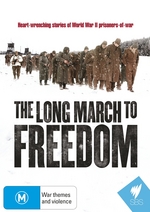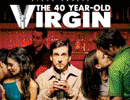The Long March to Freedom (2011) |
|
The Long March to Freedom (2011) |
|


|
| BUY IT |
| General | Extras | ||
| Category | Documentary | None | |
| Rating |

|
||
| Year Of Production | 2011 | ||
| Running Time | 141:00 | ||
| RSDL / Flipper | Dual Layered | Cast & Crew | |
| Start Up | Menu | ||
| Region Coding | 1,2,3,4,5,6 | Directed By | None Given |
|
Studio
Distributor |
 Madman Entertainment |
Starring | Bernard Hill (Narrator) |
| Case | Amaray-Transparent | ||
| RPI | $29.95 | Music | None Given |
| Video | Audio | ||
| Pan & Scan/Full Frame | None | English Dolby Digital 2.0 (224Kb/s) | |
| Widescreen Aspect Ratio | 1.78:1 | ||
| 16x9 Enhancement |
 |
||
| Video Format | 576i (PAL) | ||
| Original Aspect Ratio | 1.78:1 | Miscellaneous | |
| Jacket Pictures | No | ||
| Subtitles | None | Smoking | No |
| Annoying Product Placement | No | ||
| Action In or After Credits | No | ||
The Long March to Freedom is a three-part documentary series telling the story that few would know - the forced march of Allied prisoners of war from the Eastern front at the conclusion of World War II. It is a fascinating and often moving documentary.
Our perceptions of prisoners of war during World War II have been shaped by various media. By far the most pervasive imagery relates to the death camps the Nazis established to eliminate the Jews. These are unforgettable images of humans as mere skin and bones, dehumanised along the way to elimination. From completely the other direction we have been given the image of the POW camp as the mere half way house on the path to escape whether heroically (The Great Escape) or humorously (Hogans Heroes). Somewhere in the middle lies the truth regarding the POW experience for Allied soldiers captured by the Germans. Witness to occasional acts of brutality there were also stories of humour and great bravery.
This documentary series comprises three 47 min episodes entitled: Capture, Captivity And Freedom. Although the series is entitled The Long March to Freedom the truth is that only the final episode deals with the forced march. Although this may seem like misleading advertising the result is a carefully prepared and researched work which helps to explain the POW experience and the long marches in context. The series brings together a group of British ex-POWs, some of whom spent almost the entire war in captivity. They are genuine, honest and entertaining speakers - men who can explain what it was really like to be there in the crucible of war.
The first episode goes some way to explaining how the men ended up in captivity. Far from the image of a well drilled, well-prepared British fighting force these men explain how as youngsters they signed up for "the King's Shilling" only to be thrown into battle without much training. The stories are both funny and sad. Some of the men speak of having only shot 20 rounds with a rifle before they were shipped off to battle. The results were not surprising. The well-trained German forces defeated and captured large numbers of British troops.
Episode two brings home what life was like in captivity. Shipped in train carriages across Eastern Europe to camps the men speak of deprivation and despair as well as humour and endurance.
Episode three takes us into the heart of darkness. As the war came to a close there were some 300,000 Allied prisoners of war in captivity, many in Eastern Europe. For reasons that are still not entirely clear Hitler determined that the prisoners should be evacuated from the advancing Russian forces and taken to camps in the West. In one of the coldest winters known when temperatures dropped to -30 these men were marched relentlessly, sometimes for months without adequate food or shelter. The position was not much better for the German soldiers who were guarding them.
The men's stories vary. Some saw cruelty on the part of their guards and fellow prisoners, each man fighting for their own survival. Others saw great acts of courage and kindness on the part of the guards and locals. All speak of unbelievable hunger and cold. As well as the remembrances the episode includes footage of a yearly re-enactment of part of the march, only 60 miles, taken by some soldiers and those who want to share in the experience.
The Long March to Freedom tells a story that rarely features in popular culture. War stories tend to concentrate on the heroic battles and not those for whom the war ended in surrender and incarceration. It is essential viewing for those who like their military history documentaries.
The Long March to Freedom comes to DVD in a 1.78:1 aspect ratio which is consistent with its widescreen television origin. It is 16x9 enhanced.
The film combines several sources with varying image quality issues. To start with there are the talking heads interviews with former soldiers. These are clear and crisp with good colour and flesh tones throughout. There are also some re-enactment footage and modern day footage which is clear and crisp. Finally, there is the wartime footage which is in black and white and representative of its origins. The historical footage is replete with the sorts of artefacts and problems that you would expect.
Throughout the image quality is of high quality and is everything that a documentary fan would expect.
There are no subtitles.
| Sharpness | |
| Shadow Detail | |
| Colour | |
| Grain/Pixelization | |
| Film-To-Video Artefacts | |
| Film Artefacts | |
| Overall |
The Long March to Freedom carries a Dolby Digital 2.0 soundtrack running at 224Kb/s.
This is perfectly adequate for a documentary series which consists largely of interviews. The interviewees can be heard clearly throughout though there are a number of difficult regional accents on offer.
The series is narrated by noted British actor Bernard Hill who provides a clear and entertaining narration throughout. There are no technical problems with the sound transfer.
| Dialogue | |
| Audio Sync | |
| Clicks/Pops/Dropouts | |
| Surround Channel Use | |
| Subwoofer | |
| Overall |
There are no extras.
NOTE: To view non-R4 releases, your equipment needs to be multi-zone compatible and usually also NTSC compatible.
This is an All Regions release.
The Long March to Freedom is often amusing sometimes chilling and always compelling. The soldiers tell their stories with such honesty highlighting their own strengths and weaknesses that they cannot help but to impress.
The transfer is perfectly adequate in sound and vision terms and no documentary fan will find it wanting.
| Video | |
| Audio | |
| Extras | |
| Plot | |
| Overall |
| Review Equipment | |
| DVD | Cambridge 650BD (All Regions), using HDMI output |
| Display | Sony VPL-VW80 Projector on 110" Screen. Calibrated with Video Essentials. This display device is 16x9 capable. This display device has a maximum native resolution of 1080p. |
| Audio Decoder | Built in to amplifier/receiver. Calibrated with Ultimate DVD Platinum. |
| Amplification | Pioneer SC-LX 81 7.1 |
| Speakers | Aaron ATS-5 7.1 |